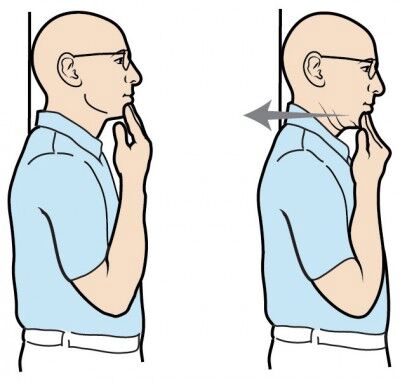Life Hack: Forward Head Posture
Life Hack: Forward Head Posture
How many times in the course of a day do you roll your shoulders and neck around to alleviate “the spot” in between your shoulder blades. There are several reasons for the discomfort you are experiencing, but one way to resolve this is to do what is known as a “chin tuck”. Sure, your co-workers may give you some funny glances, but the joke will be on them when you are the one without neck pain. Research has shown that every inch of forward head posture, results in an additional 10 lbs. of weight pulling on your posterior (back) neck muscles. The same muscles that run down your spine as well as attach to the shoulder blade. By doing this simple movement/stretch every hour or so of screen time, you will see a significant reduction in your overall discomfort in just a matter of a week.
 The best way to do this movement at first, is in front of a mirror. This way you will be able to see that you are being strict with the motion. This is an essential component of this hack.
The best way to do this movement at first, is in front of a mirror. This way you will be able to see that you are being strict with the motion. This is an essential component of this hack.
With your ears lined up over your shoulders, take both hands and place your finger tips on your chin. Press you fingers into your chin and feel the glide of your head go slightly back. The motion is small, but you should feel an immediate response at the base of your skull, known as your occiput. Once you have applied the motion, release and proceed to protrude your jaw forward and repeat the steps again (5-10 times) by pushing your fingers into your chin.
Try this one and let us know how it felt.
Ready to #feelbetter?
You're just a click away from a wicked good massage!
-

60 Minute Massage Gift Card
$170.00 Add to cart -

90 Minute Massage Gift Card
$255.00 Add to cart -

Mini Aer Small Room Air Purifier
$149.00 Add to cart -
Sale!

Thera-Pearl Sports Pack/Hot Cold
Original price was: $14.99.$12.99Current price is: $12.99. Add to cart -

3 Somadome Sessions Gift Card
$135.00 Add to cart -

20 Minute Somadome Gift Card
$45.00 Add to cart -
Sale!

TheraBand® Stretch Strap
Original price was: $19.99.$14.99Current price is: $14.99. Add to cart -

TheraBand CLX Connective Loop
$14.99 Select options
Muscle Strains
A strain, sometimes referred to as a pulled muscle, is a muscle injury produced by excessive tensile stress that causes fibers to tear within the tissue. A muscle strain does not usually result from excess stretch alone, but from a combination of tension and contraction. Muscle strains can develop when excess tension is placed on…
Read MoreShin Splints or Compartment Syndrome?
One of the most common overuse injuries affecting the lower extremity is the condition known as shin splints. While the term shin splints routinely is used, especially among the athletic population, it does not represent a specific clinical pathology. Instead, it describes chronic shin pain resulting from overuse. It occurs in two regions of the…
Read MoreAn Alternative Approach to Stretching
Clinicians, athletes and rehabilitation specialists advocate stretching as a means for injury prevention and treatment. The primary purpose of any stretching technique is to enhance pliability and flexibility in the soft tissues. It is also routinely incorporated with massage in the treatment of pain and injury conditions. There are many different stretching techniques, which all…
Read MoreGanglion Cysts
The highly refined palpation skills of massage practitioners are such that we often identify tissue abnormalities before the client is aware of them. An indication that we should refer a patient for further evaluation is when we identify something we aren’t sure of but know shouldn’t normally be there. One such example may occur with…
Read MoreWhat Is the “End Feel”?
Some of the most valuable assessment information is derived from relatively simple procedures such as passive range-of-motion tests. While many massage practitioners have been exposed to the fundamental concepts of active and passive range-of-motion testing, most have not learned how to use this information effectively in a clinical environment. In this article, we will focus…
Read MoreHow Accurate Is That Test?
Physical assessment is considered one of the most accurate ways to assess function of the locomotor tissues of the body. While we can often gain valuable information about structural problems through high-tech diagnostic procedures like X-ray or MRI, these procedures tell us very little about the function of the tissues involved in creating and limiting…
Read MoreWhen Is It Tendinitis?
Tendinitis is one of the most common diagnoses for soft tissue pain resulting from repetitive motion. As repetitive motion disorders have dramatically increased, so has the incidence of tendinitis. However, recent investigations into the cellular nature of tendon pathologies have brought forth interesting discoveries that may alter the way tendinitis is treated. In this month’s…
Read More- « Previous
- 1
- …
- 18
- 19
- 20

